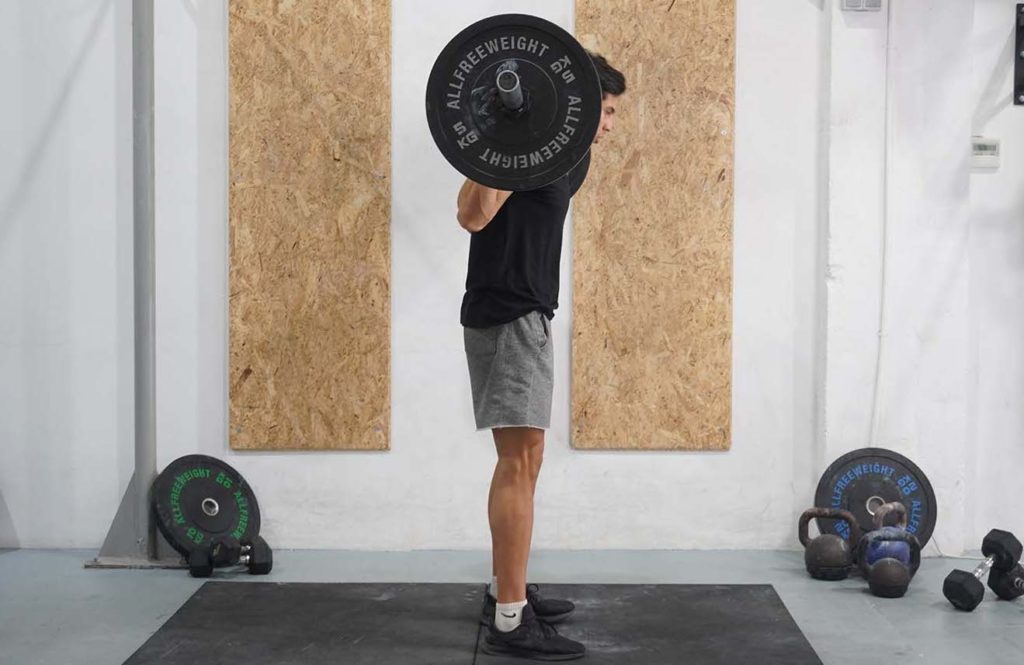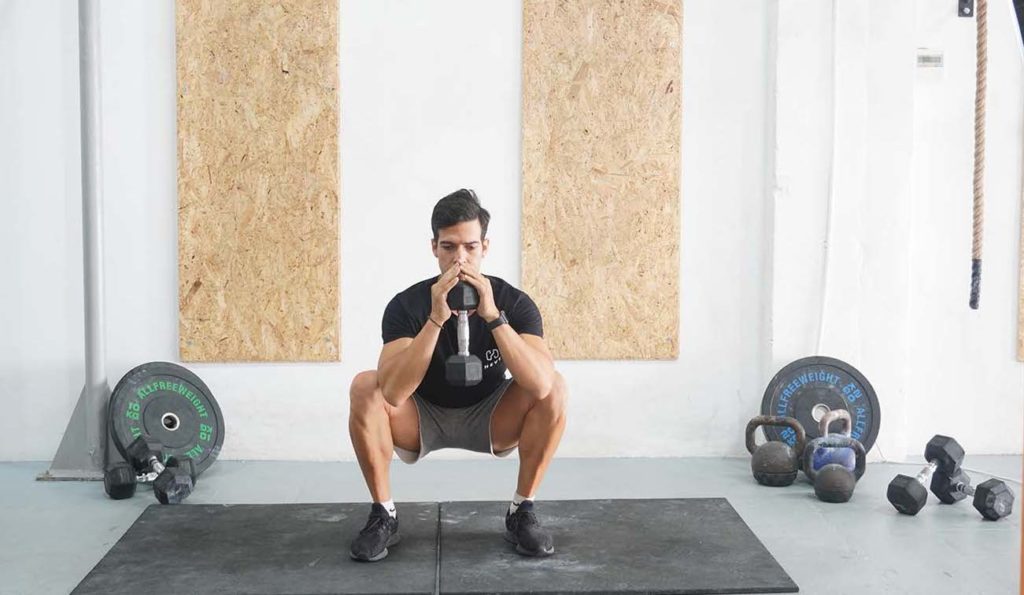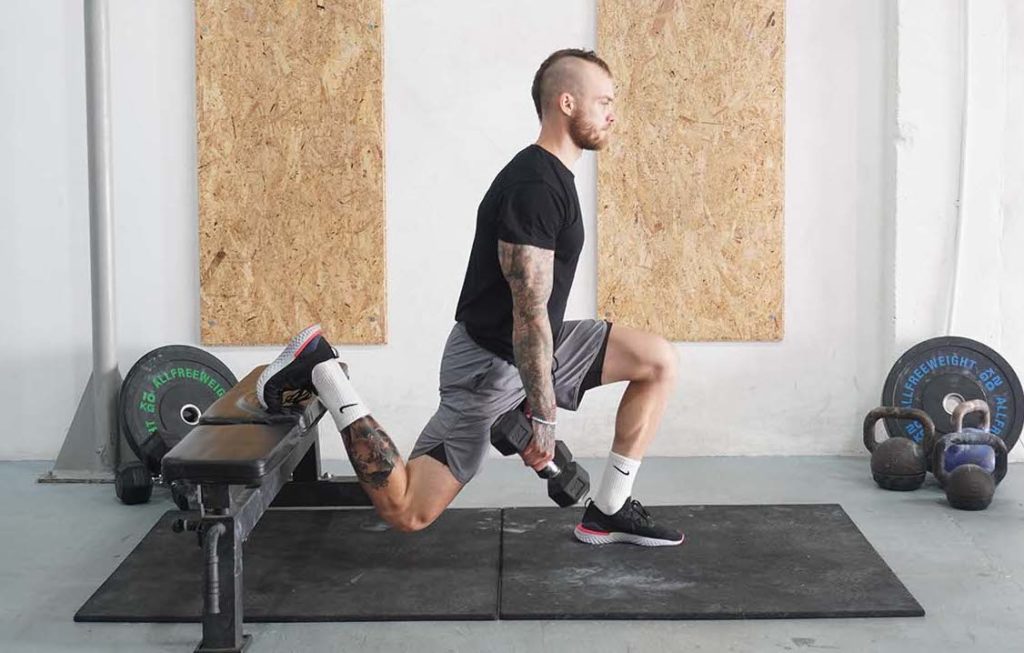The Benefits of Barbell Lunges
Barbell lunges are a somewhat overlooked movement for the lower body. Most trainees prefer to lunge with a pair of dumbbells or kettlebells, but a barbell also works excellent. The objective is to place a bar on your back, similar to how you would for a squat. But, instead of moving up and down in a squatting pattern, you must lunge forward and press yourself back to the starting position with your front leg.
A notable benefit of the barbell lunge is that you can pick from numerous variations. One option is alternatingly doing repetitions, lunging forward with one leg, then extending the opposite for the next repetition. Alternatively, you can plant one foot on the floor and do numerous stationary lunges before switching. You can even lunge backward to emphasize your posterior chain and place less stress on your knees.
Another advantage to the barbell lunge is the great overloading potential. Using a barbell allows you to train with more weight and cause significant mechanical tension in your legs. Performing lunges is also beneficial and necessary because the movement improves your balance and trains one leg at a time, reducing the risk of muscle imbalances. As a result, you become functional and much more athletic, better able to tackle everyday tasks, and stay safe while playing sports.
We recommend including the barbell lunge around the middle of your leg workout and doing the movement with a moderate load.
Level of Exercise: Intermediate
How to do a Barbell Lunges
- Set the barbell over a squat stand and have it at collarbone height.
- Stand in front of the bar, reach forward and place your hands evenly over it.
- Tuck your head underneath the bar and place your trapezius muscle against it. Have your hands close or wide––whichever feels more natural and secure.
- With your feet in line, tense your entire body, engage your abs, and take a breath.
- Extend your knees to unrack the barbell and take several careful steps back to clear enough room for lunges.
- Position your feet at a hip-width distance and take another breath.
- Lunge forward and plant your foot on the floor.
- Immediately descend into a controlled lunge while keeping your upper body stable and barbell in position.
- Descend until your back knee is an inch or two from the floor. Your front knee should be at a 90-degree angle in that position.
- Hold the bottom position for a moment and press yourself back to the starting position by engaging your front quadricep. Exhale near the top.
- Have your feet in line again, take another breath, and lunge forward, extending the opposite leg.
- Keep alternating from left to right until you finish the set.
- Once finished, walk forward to the barbell stand, position the bar over the rack and rest it on top.
What muscles does the barbell lunge activate?
Our quadriceps are the primary muscle group that works during a barbell lunge (1, 2). The muscle group makes up the front side of our thighs and produces knee extension. As we lunge forward, our quadriceps control us on the way down and produce the necessary force for us to get back to the top position.
The gluteus maximus is the second muscle group with an active role in a barbell lunge (1). Our glutes cover the buttocks area and play an essential role in hip extension, core stability, and spinal health (3). The muscle group plays a role as we descend, but its primary function is to assist the quadriceps in bringing us back to the top position after lunging forward.
Like the glutes, our hamstrings also contribute to lunges, but less so. The muscle group covers the rear of our thighs and serves two functions: hip extension and knee flexion. As we lunge forward, our hamstrings engage and assist the glutes in helping us remain stable and pushing ourselves off the bottom position.
Lunging is also beneficial for the adductors (inner thigh muscles), because they contribute to hip flexion and extension (1). The adductor magnus contributes to hip extension and assists the hamstrings and glutes during the lunge (4).
Aside from the lower body, a range of upper body muscles flex isometrically, allowing you to support the barbell behind your neck. Your entire back, chest, shoulders, arms, and midsection muscles produce force to help you remain upright as you perform lunges.
Tips on Proper Form with Barbell Lunges
Starting with an empty 20-kilogram barbell is beneficial because the load is manageable and allows you to get used to the exercise. Beginners who want to learn the barbell lunge could start with a lighter and shorter straight bar because the traditional one might be too long and heavy to handle safely.
You should always pick a load that allows you to train through a full range of motion. As you lunge forward, descend until your front thigh is almost parallel to the floor and your back knee is close to the floor. There is no point in handling a load that prevents you from training through a full range of motion.

Bring one foot forward enough when lunging forward, so your shin is vertical as you descend. Lunging forward too much might make it challenging to maintain your balance, whereas shorter strides would make the exercise feel awkward and stress your ankles unnecessarily.
Similarly, as you lunge forward, plant your entire foot into the floor, distributing your weight evenly between your toes, the ball of the foot, and the heel. Extend your leg forward, plant the foot, and sink into the lunge immediately. Press evenly through the entire leg once you reach the bottom, propelling yourself to the starting position.
Variations and Modifications of the Barbell Lunge
1. Barbell Reverse Lunge

The reverse lunge is an excellent variation of the classic exercise that effectively strengthens your posterior chain (glutes, hamstrings, and lower back). Instead of bringing your leg forward to descend into a lunge, get it back. Doing so is beneficial for emphasizing the muscles at the back and placing less stress on your knees.
2. Barbell Walking Lunge
The barbell walking lunge is a neat variation you can perform to have more fun with the exercise and introduce a true sense of progression. Instead of lunging forward, descending, and going back, you have to move forward with each repetition. You lunge forward, descend, bring the back foot forward, lunge, and keep alternating between left and right.
3. Barbell Stationary Lunge
Barbell stationary lunges are perhaps the most straightforward variation to master because you’re not alternating forward or back. Instead, you must lunge forward, plant one foot on the floor, and repeatedly descend, training the front quadricep. Once finished, bring your other foot forward and perform the same number of repetitions.
Mistakes to Avoid
Shortening the Range of Motion
Perhaps the most common error with the lunge is shortening the range of motion, which can occur for various reasons. One common cause is using too much weight, which forces trainees to use compensatory tactics to complete each repetition. Another cause is simply not having the necessary skill and balance to sink into a deep lunge. The best ways to avoid the mistake are to practice the movement consistently and pick a load you can handle safely.
Taking Short Steps Forward
The second common mistake with lunges is bringing your feet too close in front of you. Doing so might make the movement less intimidating, but each repetition becomes less effective. For one, you can’t stretch the involved muscles as effectively, which could hinder growth and strength development. Second, short steps force your knees too far in front of your toes, causing more stress and increasing the risk of aches. You should learn to take long and deep steps forward, having your front shin vertical as you descend.
Leaning Forward
Leaning forward is the third mistake to watch out for during a lunge. Trainees often lean forward because doing so allows them to engage the posterior chain more effectively and take the tension away from the primary muscles: the quadriceps and adductors. Doing so might help you do extra repetitions, but giving the primary moving muscles a break is not a good way to make them grow. Avoid the error by keeping your torso upright from start to finish, forcing your quadriceps to do most of the work.
Similar Exercises to the Barbell Lunge
Goblet Squat

Goblet squats are a practical accessory exercise that strengthens your quadriceps (5). Like a barbell lunge, the goblet squat emphasizes your quadriceps because of your more upright torso position. As a result, you cannot rely on hip extension, forcing your quads to produce more force and extend your knees. Another similarity with the barbell lunge is that you can overload your legs with a lot of weight, causing more mechanical tension for growth.
Bulgarian Split Squat

Bulgarian split squats are similar to lunges because you have to extend one leg forward and support yourself on it as you move up and down. The objective is to elevate one leg on a gym bench or chair, bring the other leg forward, do as many squat repetitions as possible, then switch, and repeat.
Dumbbell Step Up

Similar to the barbell lunge, dumbbell step ups are an effective movement for training one leg at a time (6). Stand in front of a plyo box, gym bench, or chair with a dumbbell in each hand. From there, raise one leg, plant the foot on the elevated surface and use your front quadriceps to extend your knee, moving you up. Then, lower yourself to the starting position and extend your opposite leg.

